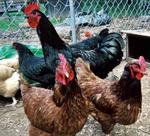Poultry Facts
Home
Poultry Vocab
Poultry Breeds
Raising Chickens
Poultry Facts
Poultry Photos
Poultry Links
Contact Me
Misc. Links
Miscellaneous Facts
Here I hope to shed some light on poultry knowledge and clear up any misconceptions people may have about poultry.
- Hens do NOT need a rooster to lay an egg- only fertilized ones.
- Hens lay every 24 hours, with several breaks each year.
- Roosters can be castrated- it prevents the meat from getting tough in non-broiler meat chickens. It also prevents crowing.
- You do not need a pond/pool/body of water to have ducks/geese! This is only entertainment for them, and if you do not have enough room, water may be too big of a mess for you to handle!
- Green eggs ARE real (the shell anyway)- they come from Americanas and Auracaunas.
- Broilers will NEVER lay an egg, even if it is female. The broiler will die regardless of whether or not you slaughter it before 6 months, therefore never reaching sexual maturity and allowing eggs to be laid. That said, broilers obviously don't reproduce; they are always crossed between a purebred Cornish hen and a White Rock rooster.
- Commercial white eggs come from Leghorns, brown eggs from Red Sex-Links or other similar crosses, and meat from broilers.
- If they don't have a heat lamp on them in the winter, hens will stop laying for their molt. Don't worry- it doesn't last long; a few weeks or so.
- Eggs should be stored pointy side down.
- Eggs can be unrefridgerated for up to two weeks. However, I wouldn't recommend it.
- The only true bantams are the Japanese and the Sebright- two very beautiful birds, might I add.
- Roosters start crowing at 6 months of age.
- You should only have one rooster for every 10-12 hens- they are very territorial.
- The little pokey things coming out of the side of a rooster's feet is called a spur. It's used to fend of predators and to fight over mates. Be careful, they hurt.
- You can tell the difference between a hen and a rooster several ways. First, MOST roosters have shiny, large, pretty feathers coming out of the tail called sickles and the hens do not. Also, some roosters are larger, and have larger combs (the red thing on the top of the chicken's head) or wattles (the red things underneath the chicken's beak).
- Chickens can live to be 12 years old- but they stop laying after 3 or 4 years.
- You CAN train chickens, though it's sort of difficult. After all, my Rhode Islands are like puppies!
- Turkens (or Naked-Necks) are a breed of chicken that looks like a cross between a chicken and a turkey, but they're not; they're just a strange, surprisingly hardy breed of chicken.
- There are some breeds of chicken where the rooster does not have the sickles on the back of the tail- these are called hen-feathered birds and they have the same feathering as a hen would. An example of this is the Sebright.
